NCERT Class 11 Physics Chapter 3 Notes Motion in a straight Line - Download PDF
Have you ever observed the way a train slides down the tracks or the way the raindrops fall down the Earth? These are real-life scenarios where motion in a straight line can be best observed, and this is among the most basic ideas of Class 11 Physics. This chapter enables the students to understand how to describe, measure and analyse motion when an object is moving through a straight line.
This Story also Contains
- NCERT Notes for Class 11 Physics Chapter 2: Download PDF
- NCERT Notes for Class 11 Physics Chapter 2
- Class 11 Physics Chapter 2 Motion in a Straight Line: Previous Year Question and Answer
- How to Master Class 11 Physics Chapter 2 Motion in a Straight Line?
- Importance of Motion in a Straight Line Class 11 Notes
- How to Use NCERT Class 11 Physics Chapter 2 Notes Effectively?
- NCERT Class 11 Notes Chapter-Wise
- NCERT Books and Syllabus
Chapter 2 of NCERT Class 11 Physics Chapter Motion in a Straight Line (also known as rectilinear motion) is the basis of kinematics, the science of mechanics that does not investigate the cause of motion. Some of the concepts discussed in NCERT Notes for Class 11 Physics Chapter 2 Motion in a Straight Line include position, displacement, speed, instantaneous velocity, acceleration and relative velocity. Motion graphs (position-time and velocity-time graphs), as well as obtaining equations of uniformly accelerated motion, will also be understood by students. These NCERT notes are written by professionals according to the latest syllabus of Physics in Class 11, which makes them easy to learn, with clear explanations, significant formulas, and solved examples. They not only present a great asset during Class 11 exams, but also create a good base before competitive exams such as JEE and NEET. The NCERT Notes for Class 11 Physics Chapter 2 Motion in a Straight Line in the form of a downloadable PDF make the revision process faster, smarter, and more effective.
Also Read,
NCERT Notes for Class 11 Physics Chapter 2: Download PDF
The Class 11 Physics Chapter 2 Motion in a straight line Notes offer systematic knowledge about major concepts, equations, and examples of solved problems, and students are able to revise faster. Motion in a straight line Class 11 Physics notes have been prepared according to the current CBSE syllabus, hence they are very trustworthy in exam preparation. Having a downloadable PDF, the students will be able to comprehend the material at any time and read it to study effectively and perform better.
NCERT Notes for Class 11 Physics Chapter 2
The Class 11 Physics Chapter 2 Motion in a straight line Notes allow the students to understand this chapter in a simple and straightforward way. They describe some of the basic terms like position, displacement, velocity, acceleration, and graphs of motion in a simple manner. Class 11 Physics Chapter 2 Motion in a straight line Notes are developed according to the NCERT curriculum, having brief points that enable learners to study, revise and remember important points in an easier way.
Rest and Motion
An object is said to be at rest if it remains stationary in relation to a specific frame of reference over time. On the other hand, if an object's position relative to a frame of reference changes over time, it is said to be in motion. A coordinate system to which observers attach coordinates to describe events and observations is referred to as a frame of reference.
Frame of Reference
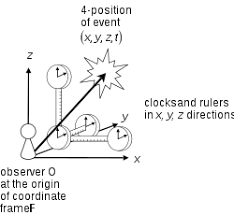
- A frame of reference is a coordinate system used to describe the position and motion of objects by providing a set of axes relative to an observer's perspective.
- According to the frame of reference:
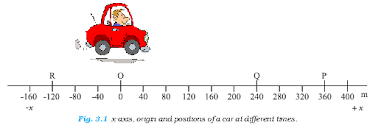
- A body is considered in motion if its position changes over time relative to that frame, and it is considered at rest if there is no change in its position within that frame of reference. For instance, when observing a moving vehicle from an external reference frame, it appears to be in motion, while from an internal frame within the vehicle, the surroundings may seem stationary.
Motion Along a Straight Line
- A straight-line motion can be effectively described using only the X-axis of a coordinate system. One-dimensional motion is the movement of a body in a straight line that occurs when only one coordinate of the body's position changes with time. Examples of one-dimensional motion include the motion of a car on a straight road and the motion of a freely falling body.
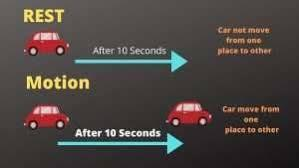
Path Length (Distance) Vs. Displacement
- Path Length: The distance between two points along a route, a scalar quantity that represents the total length travelled.
- Displacement: The change in position of a body, often denoted by ∆x = (x2 - x1), and it is a vector quantity indicating the overall change in position. In short, path length considers the total distance travelled, whereas displacement considers the net change in position from the initial to the final point while taking direction into account.
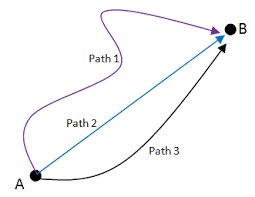
-
The magnitude of displacement may or may not be equal to the length of the path.
-
When an object returns to its original position along a path with a non-zero length, displacement can be zero. Displacement takes into account the change in position regardless of the total distance travelled, as well as the direction of motion.
Speed
- Speed is defined as the rate at which distance is covered with time. Here are some characteristics of speed:
- It is a scalar quantity denoted by the symbol v.
- Dimension: [MoL1T-1]
- Unit: Meter/second (S.I.), cm/second (C.G.S.)
- Types of speed
(a) Uniform speed: A particle moves at uniform speed when it covers equal distances in equal intervals of time, regardless of how small those intervals are. For example, a car travels an equal distance of 5 metres per second, indicating a uniform speed of 5 m/s. Uniform speed denotes a constant rate of motion with no acceleration or deceleration during the time intervals specified.
(b) Non-uniform (variable) speed: A particle with non-uniform (variable) speed travels unequal distances in equal time intervals. For example, a car travels 5m in the first second, 8m in the second second, 10m in the third second, 4m in the fourth second, and so on. This variation in distance covered indicates that the particle's speed varies for each one-second interval, confirming that it moves at a variable speed. Variable speed denotes that the rate of motion varies over time.
(c) Average speed: The average speed (Vavg) of a particle for a given interval of time is defined as the ratio of the total distance travelled (d) to the total time taken (t).
(d) Instantaneous speed: It is the speed of a particle at a specific point in time. When we talk about "speed," we usually mean instantaneous speed.
Velocity
- Velocity is defined as the rate of change of position or the rate of displacement with time.
- It is a vector quantity having the symbol v.
- Dimension of velocity: [M0L1T-1]
- Unit: Meter/second (S.I.), cm/second (C.G.S.)
- Types of Velocity
(1) Uniform velocity: The condition in which both the magnitude and direction of an object's velocity remain constant is referred to as uniform velocity. This occurs when the particle continues to move in the same straight line without changing direction. To put it another way, a particle with uniform velocity must travel at a constant speed along a straight path with no change in motion.
(2) Non-uniform velocity: Changes in the magnitude or direction of the velocity, or both, characterise non-uniform velocity. The particle's speed and/or direction of motion may change in this scenario. Non-uniform velocity indicates that the object is not moving in a straight line at a constant speed, but rather has variations in its motion over time.
(c) Average velocity: It is defined as the ratio of the body's displacement to the time it takes.
(d) Instantaneous velocity: Instantaneous velocity is defined as the rate of change of the position vector of a particle with respect to time at a specific instant.
Instantaneous Velocity and Speed
In real-life motion, the speed or velocity of an object may not remain constant throughout its journey. To understand how fast an object is moving at a particular instant of time, we define the concepts of instantaneous speed and instantaneous velocity.
Instantaneous Speed
Instantaneous speed is the speed of an object at a particular moment of time. It is the limit of average speed as the time interval approaches zero. In simpler terms, it tells us how fast an object is moving at an instant.
where
Instantaneous speed is a scalar quantity and is always positive.
Instantaneous Velocity
Instantaneous velocity is defined as the velocity of an object at a particular instant of time. Like instantaneous speed, it is obtained by taking the limit of the average velocity as the time interval tends to zero.
where
is the displacement vector and
Instantaneous velocity is a vector quantity and has both magnitude and direction.
Acceleration
- Acceleration is defined as the time rate at which an object's velocity changes. it tells us how quickly and in which direction an object's velocity is changing. It is expressed in acceleration units such as metres per second squared.
- It is a vector quantity with the same direction as the change in velocity (not the velocity itself).
- Dimension of acceleration:
- Units: $\left[\right.$ meter $(\mathrm{m}) /$ second $\left.2\left(\mathrm{~s}^2\right)\right]$ in (S.I.), $\left[\right.$ centimeter $(\mathrm{cm}) /$ second $\left.2\left(\mathrm{~s}^2\right)\right]$ in (C.G.S.).
- Types of Acceleration
(a) Uniform acceleration: Uniform acceleration refers to a situation in which both the magnitude and direction of the acceleration of a body remain constant during its motion.
(b) Non-uniform acceleration: A body is said to have non-uniform acceleration if there are changes in either the magnitude or direction of acceleration, or both, during its motion.
(c) Average acceleration: The average acceleration of an object is defined as the change in velocity per unit time.
Position-Time, Velocity-Time, and Acceleration-Time Graph
|
Parameters |
p-t Graph |
v-t Graph |
a-t Graph |
|
X and Y axes |
Time and Position |
Time and Velocity |
Time and Acceleration |
|
Slope |
It gives the velocity of an object |
It gives the acceleration of an object. |
It gives a push to a moving object. |
|
Straight slope |
It gives uniform velocity |
It gives uniform acceleration | The slope of an a–t graph represents the rate of change of acceleration with time |
|
Curvy Slope |
Change in velocity |
Change in acceleration |
Change in the amount of push |
p-t graph
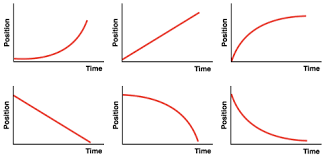
v-t graph
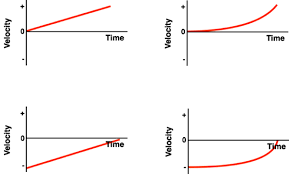
Kinematic Equations for Uniformly Accelerated Motion
Using the velocity-time graph of the object under uniformly accelerated motion, we can derive a simple set of equations that relate displacement
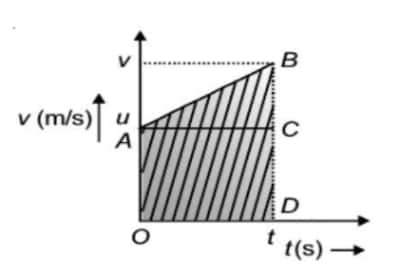
1. Derivation of the velocity-time relation
The slope of the graph gives the acceleration a of the object.
2. Derivation of displacement-time relation
The area under this curve is
Area of $\triangle A B C+$ area of rectangle $O A C D$
Area of $\triangle A B C=\frac{1}{2} \times(v-u) t$
Area of rectangle $O A C D=\mathrm{ut}$
And as explained in the previous section, the area under $v-t$ curve represents the displacement. Therefore, the displacement $s$ of the object is
$
s=\frac{1}{2}(v-u) t+u t-\cdots-(\mathrm{ii})
$
But $(v-u)=a t$ [from equation (i)]
Substituting this value in the above equation, we get
$
\text { or } s=u t+\frac{1}{2} a t^2
$
3. Derivation of the velocity-displacement relation
Now, the area of trapezium $O A B D=\frac{1}{2}$ (sum of parallel sides) $\times$ perpendicular distance between the parallel sides.
$
\begin{gathered}
S=\frac{1}{2} \times(O A+B D) \times O D \\
S=\frac{1}{2}(u+v) \times t
\end{gathered}
$
From equation (i), we get
$
t=\frac{v-u}{a}
$
Substituting this value of $t$ in the equation, we get
$
\begin{array}{cc}
s=\frac{1}{2}(u+v) \times \frac{(v-u)}{a} \\
\Rightarrow s=\frac{v^2-u^2}{2 a} \\
\Rightarrow v^2-u^2=2 a s
\end{array}
$
$s$ is the displacement of the object in the time interval $t$ and is given by the change in the position from $x_0$ to $x$
$
s=\left(x-x_0\right)
$
So the three kinematic equations of uniformly accelerated motion that we have derived so far are
$
\begin{aligned}
v & =u+a t \\
x-x_0 & =u t+\frac{1}{2} a t^2 \\
v^2-u^2 & =2 a\left(x-x_0\right)
\end{aligned}
$
Relative Velocity
The relative velocity of an object
if
$\vec{v}_A$ is the velocity of object A, and
$\vec{v}_B$ is the velocity of object B, then the relative velocity of $A$ with respect to $B$ is given by:
$
\vec{v}_{A B}=\vec{v}_A-\vec{v}_B
$
Similarly, the relative velocity of $B$ with respect to $A$ is:
$
\vec{v}_{B A}=\vec{v}_B-\vec{v}_A=-\vec{v}_{A B}
$
Class 11 Physics Chapter 2 Motion in a Straight Line: Previous Year Question and Answer
Class 11 Physics Chapter 2 – Motion in a Straight Line: Previous Year Questions and Answers help students understand how concepts like distance–displacement, speed–velocity, acceleration, and motion graphs are tested in exams. These questions highlight the most important formulas and problem-solving patterns used in board and competitive exams. By practicing them, students can strengthen their understanding of kinematics and improve accuracy in numerical-based questions.
Q1: A ball is bouncing elastically with a speed of 1 m/s between the walls of a railway compartment of size 10 m in a direction perpendicular to the walls. The train is moving at a constant velocity of 10 m/s parallel to the direction of motion of the ball. As seen from the ground,
a) The direction of motion of the ball changes every 10 seconds
b) The speed of the ball changes every 10 seconds
c) The average speed of the ball over any 20-second intervals is fixed
d) the acceleration of the ball is the same as that of the train
Answer:
The correct answers are:
(b) The speed of the ball changes every 10 seconds.
(c) The average speed of the ball over any 20-second interval is fixed.
(d) The acceleration of the ball is the same as that of the train.
Explanation: If we observe the motion from the ground, we will see that the ball strikes the wall every 10 seconds. The direction of the ball is the same since it is moving at a very small speed in the moving train; therefore, it will not change w.r.t. observer to the Earth.
The speed of the ball can change after a collision; hence, statement (a) will be discarded and statement (b) will be verified.
The average speed of the ball at any time remains the same or is $1 \mathrm{~m} / \mathrm{s}$, i.e., it is uniform.
Hence, statement (c) is also verified.
When the ball strikes the wall, the initial speed of the ball will be in the direction of the moving train w.r.t. the ground as well, and its speed will also change (vTG)
Thus, $V_{T G}=10+1=11 \mathrm{~m} / \mathrm{s}$
The speed of the ball after collision with a side of the train is in the opposite direction to the train.
$
\left(v_{B G}\right)=10-1=9 \mathrm{~m} / \mathrm{s}
$
Thus, the magnitude of acceleration on both the walls of the compartment will be the same, but in opposite directions. Hence, statements (b), (c) & (d) are verified here.
Q2:
The variation of quantity A with quantity B, plotted in Fig. 3.2 describes the motion of a particle in a straight line.
(a) Quantity B may represent time.
(b) Quantity A is velocity if motion is uniform.
(c) Quantity A is displacement if motion is uniform.
(d) Quantity A is velocity if motion is uniformly accelerated.
Answer:
The correct answers are:
(a) Quantity B may represent time.
(c) Quantity A is displacement if the motion is uniform.
(d) Quantity A is velocity if the motion is uniformly accelerated.
Explanation:
Verification of statements (a) & (d)
If quantity B had represented velocity instead of time, then the graph would’ve become a straight line, viz., uniformly accelerated motion; hence, the motion is not uniform.
Verification of statement (c)
If A represents displacement and B represents time, then the graph will be a straight line, which would represent uniform motion.
Q3:
The displacement of a particle is given by $x=(t-2)^2$ where x is in metres and t is in seconds. The distance covered by the particle in the first 4 seconds is
(a) 4 m
(b) 8 m
(c) 12 m
(d) 16 m
Answer:
Explanation: It is given that $x=(t-2)^2$
Now, we know that,
$
\begin{aligned}
V & =\frac{d x}{d t} \\
& =2(t-2) \mathrm{m} / \mathrm{s}
\end{aligned}
$
$
\begin{aligned}
a= & \frac{d^2 x}{d t^2} \\
& =2(1-0) \\
& =2 \mathrm{~ms}^{-2}
\end{aligned}
$
Now,
$
\begin{array}{ll}
v_0=2(0-2)=-4 m / \mathrm{s} & \ldots \ldots \ldots \ldots(\text { at } t=0) \\
v_2=2(2-2)=0 \mathrm{~m} / \mathrm{s} & \ldots \ldots \ldots \ldots(\text { at } t=2) \\
v_4=2(4-2)=4 \mathrm{~m} / \mathrm{s} & \ldots \ldots \ldots \ldots(\text { at } t=4)
\end{array}
$

$\begin{aligned} & =\frac{1}{2}(2.4)+\frac{1}{2}(2.4) \\ & =8 \mathrm{~m}\end{aligned}$
Hence, the correct answer is option (b).
How to Master Class 11 Physics Chapter 2 Motion in a Straight Line?
Chapter 2, Motion in a Straight Line, is the beginning of the study of kinematics, which explains the movement of objects along one direction. In order to score highly, the students are expected to have the concepts of displacement, velocity, acceleration, and graphical interpretation of motion. The study of this chapter develops good analytical abilities in future Physics chapters and competitive tests such as JEE and NEET.
- Begin by having a clear conceptual grasp of the distinction between distance and displacement and speed and velocity, as a number of questions are asked to test conceptual clarity.
- Study the three equations of motion, when to use them and how they are derived to be more solid on your fundamentals.
- Practice solving numerical problems of uniform and non-uniform motion, particularly the problems whose acceleration is constant.
- Focus on motion-time, velocity-time, and acceleration-time graphs, as graphical problems frequently appear in exams.
- Attempt those questions in which you need to interpret slopes and areas of graphs to find physical quantities, which will help you get full marks in numerical questions.
- NCERT examples, in-text questions, and exercise questions should be solved as they are closely related to examination patterns.
- Practice past year questions to know some of the frequently popular models and levels of difficulty.
- Go through errors every now and then and have a list of formulas to revise easily.
Importance of Motion in a Straight Line Class 11 Notes
The Motion in a straight line Class 11 Physics Chapter 2 CBSE notes are significant because they form the basis of the field of physics known as kinematics. Complex concepts such as displacement, velocity and acceleration are made easier to learn and use using these notes. Motion in a straight line Class 11 Physics Chapter 2 CBSE notes are well explained and comprise formulas and examples, and can thus be used to revise quickly when necessary during examination time and to prepare for competitive exams such as JEE and NEET.
Strong Foundation for Higher Studies
- Motion in a straight line Class 11 Notes assists the student to develop a clear picture of kinematics in a one-dimensional system, which is a prerequisite to higher-order ideas in mechanics, rotational motion and dynamics.
Time-Saving Revision Material
- Properly organised NCERT Class 11 Physics Chapter 2 Notes enable students to memorise all formulas, graphs and derivations within a short period of time before examinations and thus save a lot of time.
Enhances Problem-Solving Abilities
- The notes contain conceptual excellence on displacement, velocity, acceleration, and motion graphs, and this enhances the precision in solving problems in CBSE exams, JEE, and NEET.
Includes All Significant Formulas
- Students receive a brief list of equations of motion, graphical relations and derivations, and they do not need to skip important formulae in last-minute revision.
Exam-Oriented Preparation
- NCERT Class 11 Physics Chapter 2 Notes pinpoint key points and past exam directions so that one can concentrate on areas that will score more marks.
Helps Competitive Exam Aspirants
- Linear motion is a very important chapter for JEE Mains, JEE Advanced and NEET Physics. These notes make complicated ideas easier and the practice more effective.
Improves Conceptual Learning
- The Motion in a straight line Class 11 Notes describe the practical examples of a motion (such as a car that moves on a straight road), and the students can connect theory to the real-life examples.
How to Use NCERT Class 11 Physics Chapter 2 Notes Effectively?
Using the NCERT notes Class 11 Physics Chapter 2 Motion in a straight line effectively can make learning easier and faster. With clear explanations, solved examples, and key formulas, these notes are designed to help students grasp concepts quickly, practice problems efficiently, and revise topics confidently for exams and competitive tests.
- Start with Concepts: Begin by reading the short, clear explanations to understand key concepts like displacement, velocity, acceleration, and relative motion.
- Learn Formulas: Note down all important formulas separately and understand their derivation and applications.
- Solve Examples: Practice the solved examples in the notes to see how theory is applied in problems.
- Revise Graphs: Pay special attention to position-time and velocity-time graphs, as they are frequently asked in exams.
- Self-Assessment: After studying, attempt unsolved numerical problems from the textbook or previous year questions to reinforce understanding.
- Regular Revision: Use the notes for quick daily revisions before exams for better retention.
NCERT Class 11 Notes Chapter-Wise
NCERT Class 11 Notes Chapter-wise provide concise, well-structured summaries of all Physics chapters as per the latest CBSE syllabus. These notes help students grasp key concepts, formulas, and derivations quickly, making them ideal for board exams and competitive exams like JEE and NEET. With chapter-wise links, you can easily navigate and revise topics in an organised way.
Subject-Wise NCERT Exemplar Solutions
- NCERT Exemplar Class 11 Solutions
- NCERT Exemplar Class 11 Maths
- NCERT Exemplar Class 11 Physics
- NCERT Exemplar Class 11 Chemistry
- NCERT Exemplar Class 11 Biology
Subject-Wise NCERT Solutions
NCERT Books and Syllabus
Frequently Asked Questions (FAQs)
Distance is a scalar quantity representing the total path length traveled by an object, regardless of direction. Displacement, on the other hand, is a vector quantity that denotes the shortest straight-line distance from the initial to the final position, including direction.
Yes, velocity can be negative. The sign of velocity indicates direction. For example, if an object moving to the right is considered positive, then motion to the left would be negative velocity.
An object is accelerating uniformly if its velocity changes by equal amounts in equal intervals of time. This is typically indicated by a straight line with a constant slope on a velocity-time graph
Understanding motion in a straight line is fundamental to physics as it lays the groundwork for more complex motions and dynamics. It helps in analyzing and predicting the behavior of objects under various forces and is essential for solving real-world problems in mechanics.
In uniform motion, an object covers equal distances in equal intervals of time, resulting in a constant velocity. In non-uniform motion, the object covers unequal distances in equal intervals, indicating a change in velocity over time
The SI (International System of Units) units for velocity, speed, and acceleration are as follows:
- Velocity: Meter per second (m/s)
- Speed: Meter per second (m/s)
- Acceleration: Meter per second squared (m/s²)
Retardation refers to the decrease in velocity or the negative acceleration of an object, indicating a slowing down of its motion.
Courses After 12th
Applications for Admissions are open.
As per latest syllabus. Physics formulas, equations, & laws of class 11 & 12th chapters
JEE Main Important Chemistry formulas
Get nowAs per latest syllabus. Chemistry formulas, equations, & laws of class 11 & 12th chapters
JEE Main high scoring chapters and topics
Get nowAs per latest 2024 syllabus. Study 40% syllabus and score upto 100% marks in JEE
JEE Main Important Mathematics Formulas
Get nowAs per latest syllabus. Maths formulas, equations, & theorems of class 11 & 12th chapters

